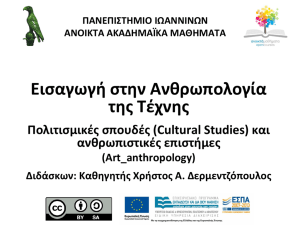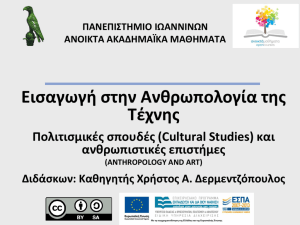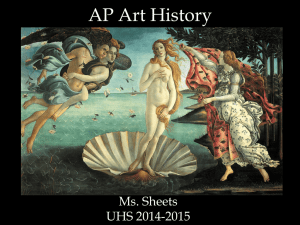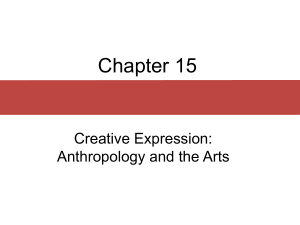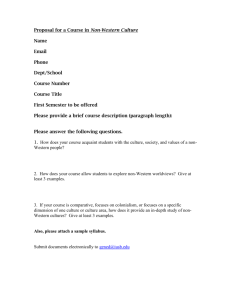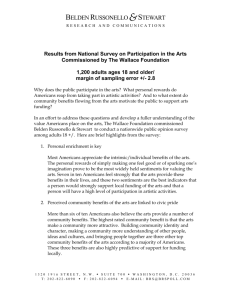Art - UOI - Πανεπιστήμιο Ιωαννίνων
advertisement
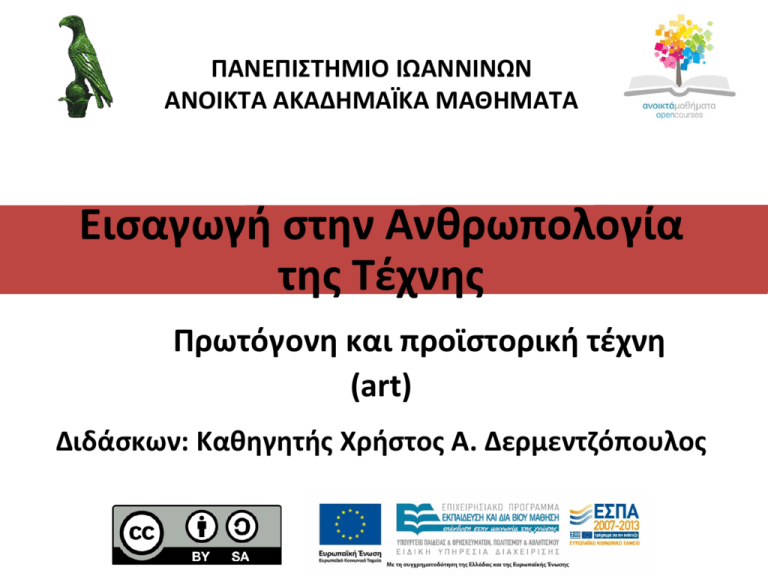
ΠΑΝΕΠΙΣΤΗΜΙΟ ΙΩΑΝΝΙΝΩΝ ΑΝΟΙΚΤΑ ΑΚΑΔΗΜΑΪΚΑ ΜΑΘΗΜΑΤΑ Εισαγωγή στην Ανθρωπολογία της Τέχνης Πρωτόγονη και προϊστορική τέχνη (art) Διδάσκων: Καθηγητής Χρήστος Α. Δερμεντζόπουλος Άδειες Χρήσης Το παρόν εκπαιδευτικό υλικό υπόκειται σε άδειες χρήσης Creative Commons. Για εκπαιδευτικό υλικό, όπως εικόνες, που υπόκειται σε άλλου τύπου άδειας χρήσης, η άδεια χρήσης αναφέρεται ρητώς. Chapter 15 Creative Expression: Anthropology and the Arts Chapter Outline Some Characteristics of Art. Some Functions of Art. The Arts and the Expression of Cultural and Personal Identity. The Artist in Society: Artists and Their Audiences. Marketing Cultural Identities Through the Arts. Art Universal means of expressing the identity of a culture. Evidence of art appears early in the human fossil record. There is no known culture without art. Understanding Art in Culture In most societies, art is inseparable from other activities. Separation of art from social behavior is characteristic of modern society. In non-industrial societies, art is embedded in all aspects of culture. Question Emphasis upon both the ways in which non-Western art is produced and is viewed within a culture a) is a major focus of art historians' approach to non-Western art. b) is considered by anthropologists to be essential for understanding the meanings of all forms of artistic expression. c) is traditionally an important aspect of museum displays prepared by art historians. d) is central to approaches of both art historians and anthropologists. Answer: b Emphasis upon both the ways in which non-Western art is produced and is viewed within a culture is considered by anthropologists to be essential for understanding the meanings of all forms of artistic expression. Five Types of Arts Graphic and plastic arts. Music. Dance. Folklore. Sports and games. Functions of Art Communication with and control over nature and the supernatural. Display of cultural themes. Cultural and social integration. Express cultural identity and history. Communication With Natural World Cave paintings represent the restoration to nature of the animals that are killed. Ritual art, dedicated to the spirits who protect life, lessens danger. Dance movements imitating animals are believed to exert control over animals. Question Prehistoric cave paintings of an animal's image or contemporary hunter and gatherer's dance movements that imitate the movements of animals illustrate all except which of the following statements? a) Hunter-gatherers primarily created art and dance for its own sake. b) Art was used as a protection from danger. c) Art styles reflect a cosmology that included an active and personal force of nature. d) Art had a central function as part of ritual acts to maintain or control the relationship with nature. Answer: a Prehistoric cave paintings of an animal's image or contemporary hunter and gatherer's dance movements that imitate the movements of animals do not illustrate the following statements: – Hunter-gatherers primarily created art and dance for its own sake. Symbolic Communication Symbolic elements in art are culturally specific: In Western culture, the phrase “once upon a time” is a signal for a fairy tale. Totem poles reflect the social hierarchy in their societies. Foster Harmony in Society The arts make dominant cultural themes visible, tangible, and more real. The arts give voice to disunity and conflict within a society. Express Cultural Identity and History In many cultures, the most important artistic efforts represent ancestors. In Imperial China, the arts were central in legitimizing the emperor. Deep Play: Balinese Cockfight Symbolic contest between male egos. Expresses Balinese social hierarchy. Question Which of the following does not illustrate ways in which art conveys important information about the social hierarchy? a) portraits of Inca kings commissioned by Inca royalty after the Spanish conquest. b) totem poles of the Northwest Coast Native Americans. c) memory boards of the Luba of Zaire. d) Balinese cockfights. e) paleolithic cave paintings. Answer: e Paleolithic cave paintings do not illustrate ways in which art conveys important information about the social hierarchy. Ledger Drawings Drawings, in ledger books, made by some Native American peoples to record personal and historical events. Types of Art Body Art – Marking and adorning the body as an expression of cultural and personal identity, or which serves other functions. Orientalism – Scholarship and art generated by Europeans focusing on the Middle East. “Primitive” Art – The term used by the Western art world for the art of non-Western, “tribal” societies. Quick Quiz 1. From the broad anthropological perspective taken in this chapter's discussion and analysis of art and artistic expression, it appears that a) what is "art" can be determined by universal standards. b) the phrase "art for art's sake" is the most useful way to understand the place of artistic expression within diverse cultures. c) art is inseparable from other activities in most non-Western societies, and is not produced or performed solely for giving pleasure. d) art and artistic expression must be viewed as outside of its specific cultural context. Answer: c From the broad anthropological perspective taken in this chapter's discussion and analysis of art and artistic expression, it appears that art is inseparable from other activities in most non-Western societies, and is not produced or performed solely for giving pleasure. 2. Creative acts such as dancing, weaving, singing, or playing a musical instrument in non-Western societies a) do not necessarily occur as an 'art form' or 'artistic performance' in itself. b) are generally expected to adhere to tradition, a high value being placed upon following or repeating the traditional form. c) are characterized by innovations or new designs or movements. d) reflect their culture's expectation that artistic expression be unique and original. e) rest upon the reputation and recognized skill of the individual artist/performer. Answer: b Creative acts such as dancing, weaving, singing, or playing a musical instrument in non-Western societies are generally expected to adhere to tradition, a high value being placed upon following or repeating the traditional form. 3. Changes in artistic style, along with innovations in technique, appear a) in cultures where artistic production is not generally valued. b) to increase when art is not primarily associated with religion. c) to have been much more significant in prehistoric times, as documented by archaeologists. d) in all cultures at approximately the same rate. e) to be more frequent in sedentary agricultural societies, where there is more time for creative expression. Answer : b Changes in artistic style, along with innovations in technique, appear to increase when art is not primarily associated with religion. Τέλος Ενότητας Χρηματοδότηση Το παρόν εκπαιδευτικό υλικό έχει αναπτυχθεί στα πλαίσια του εκπαιδευτικού έργου του διδάσκοντα. Το έργο «Ανοικτά Ακαδημαϊκά Μαθήματα στο Πανεπιστήμιο Ιωαννίνων» έχει χρηματοδοτήσει μόνο τη αναδιαμόρφωση του εκπαιδευτικού υλικού. Το έργο υλοποιείται στο πλαίσιο του Επιχειρησιακού Προγράμματος «Εκπαίδευση και Δια Βίου Μάθηση» και συγχρηματοδοτείται από την Ευρωπαϊκή Ένωση (Ευρωπαϊκό Κοινωνικό Ταμείο) και από εθνικούς πόρους. Σημειώματα Σημείωμα Ιστορικού Εκδόσεων Έργου Το παρόν έργο αποτελεί την έκδοση 1.0. Έχουν προηγηθεί οι κάτωθι εκδόσεις: Έκδοση 1.0 διαθέσιμη εδώ. http://ecourse.uoi.gr/course/view.php?id=1201. Σημείωμα Αναφοράς Copyright Πανεπιστήμιο Ιωαννίνων, Διδάσκων: Καθηγητής Χρήστος Α. Δερμεντζόπουλος. «Εισαγωγή στην Ανθρωπολογία της Τέχνης. Πρωτόγονη και προϊστορική τέχνη, art». Έκδοση: 1.0. Ιωάννινα 2014. Διαθέσιμο από τη δικτυακή διεύθυνση: http://ecourse.uoi.gr/course/view.php?id=1201. Σημείωμα Αδειοδότησης Το παρόν υλικό διατίθεται με τους όρους της άδειας χρήσης Creative Commons Αναφορά Δημιουργού - Παρόμοια Διανομή, Διεθνής Έκδοση 4.0 [1] ή μεταγενέστερη. • [1] https://creativecommons.org/licenses/by-sa/4.0/.
